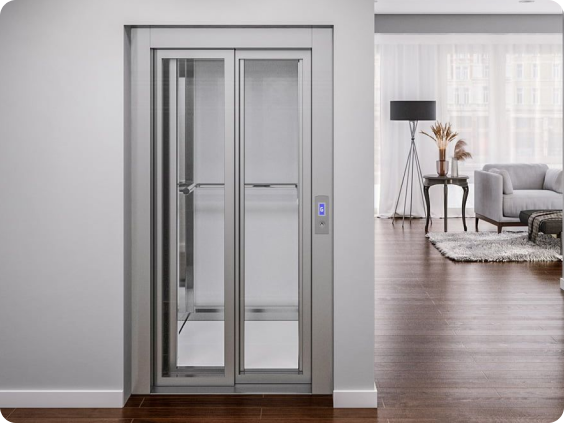Hydraulic home lifts
A hydraulic homelift is a type of elevator powered by an electrically operated pump that moves fluid through a jack and piston to lift the car. Unlike electric homelifts, hydraulic lifts require a dedicated hydraulic drive unit built into the home, making them larger and more expensive. This fluid-based movement ensures a smooth and quiet ride, but the installation process is more complex. It involves installing both a pump and a tank, which requires additional space and structural modifications.
Key features of a residential hydraulic lift
Smooth and quiet
Hydraulic lifts use fluid pressure to move the elevator, making them quieter than mechanical systems. The pressure is gently increased to lift the car and released gradually for descent, ensuring a smooth, vibration-free ride.
Suitable over multiple stories
It can travel over two or more floors, which is ideal for much larger and taller homes.
Substantial structure with a higher weight capacity
A hydraulic lift differs from an electric homelift due to a separate hydraulic pump, which is integrated into the structure of the house. This design allows it to manage heavier loads, supported by the powerful hydraulic fluid system that ensures smooth and efficient operation.
Advantages of a hydraulic lift
A hydraulic homelift can be a practical choice for larger homes or where a higher weight capacity is needed.
- Known for reliability and consistent performance
- More spacious, especially in terms of headroom, because the lifting mechanism isn’t incorporated into the top of the lift car
Disadvantages of a hydraulic lift
Hydraulic homelifts are not suitable for all homes and users. They need significantly more space compared to electric homelifts and often involve extensive structural modifications for installation. There are some other key disadvantages, including:
- Higher costs compared to electric homelifts
- Additional space is needed for both the shaft and the installation of a pump and tank, which can be obtrusive
- Can be subject to oil leaking
- The installation process is longer and more invasive, typically requiring substantial preparation and alterations.
- Whilst it is a vibration-free ride, the pump and space around the pump will likely be noisy and will vibrate
Installation and maintenance
Hydraulic lifts require more upheaval to install because they rely on a shaft, and the pump needs to be installed elsewhere and is not self-contained like other models. An installation of this kind might take anywhere from five to twelve days.
Regular servicing is essential for a hydraulic homelift, with high-quality models often requiring up to four service visits per year. The remote placement of the hydraulic pump simplifies access for maintenance, ensuring servicing is more straightforward.

Midilift CL & CLS cabin lifts for homes
A hydraulic vertical platform lift with a cabin and automatic operation.
- The CLS can carry up to 400kg over up to five floors.
- The CL is slightly smaller, able to carry up to 385kg, but can travel up to seven floors.
- Both the CL and CLS are low pit lifts, meaning the large space above the lift shaft is not needed. This means they can fit into restricted and unconventional spaces, such as in older buildings.
PL home platform lift
A hydraulic, compact platform lift is most commonly used as a wheelchair lift.
- The PL can carry up to 400kg over up to five floors.
- The PL is especially suited for use as a wheelchair access lift.
- Unlike most hydraulic lifts, the PL does not require a shaft to be built; it is contained within its own structure.

FAQs
How do hydraulic homelifts work?
A hydraulic homelift operates using an electrically powered pump. Fluid is pushed through a jack and piston, and the pressure of this lifts the car up. The pressure is released through a valve to lower the car back down again. Hydraulic homelifts can be bigger than electric homelifts due to the necessity of a pump.
How much space is needed for a hydraulic homelift?
A hydraulic homelift requires a lot more space than an electric homelift due to the pump. They are suitable for much larger homes.
Are hydraulic homelifts safe?
Hydraulic homelifts come with a variety of safety features, such as:
- A safety valve to regulate the flow of hydraulic fluid to prevent the lift from free-falling
- Alternative breaking mechanisms
- Emergency battery power capability in case there is a power cut
- Emergency stop button
Can a hydraulic homelift be installed in an existing home?
A hydraulic homelift can be installed in your home once you are already moved in. Hydraulic homelifts only work in much larger homes, and if you are already moved in, it will require a bit of thought into where to install the lift shaft so that it is not obstructive to your living space. An installation of this kind might take anywhere from five to twelve days.
What maintenance does a hydraulic homelift require?
A hydraulic homelift requires more frequent services than an electric homelift. A quality product may require four service visits per year from a lift expert.

Enhance your comfort and efficiency.
If you would like to know more about having a hydraulics homelift installed in your home, you can request a free consultation here. Alternatively, explore other types of homelifts.